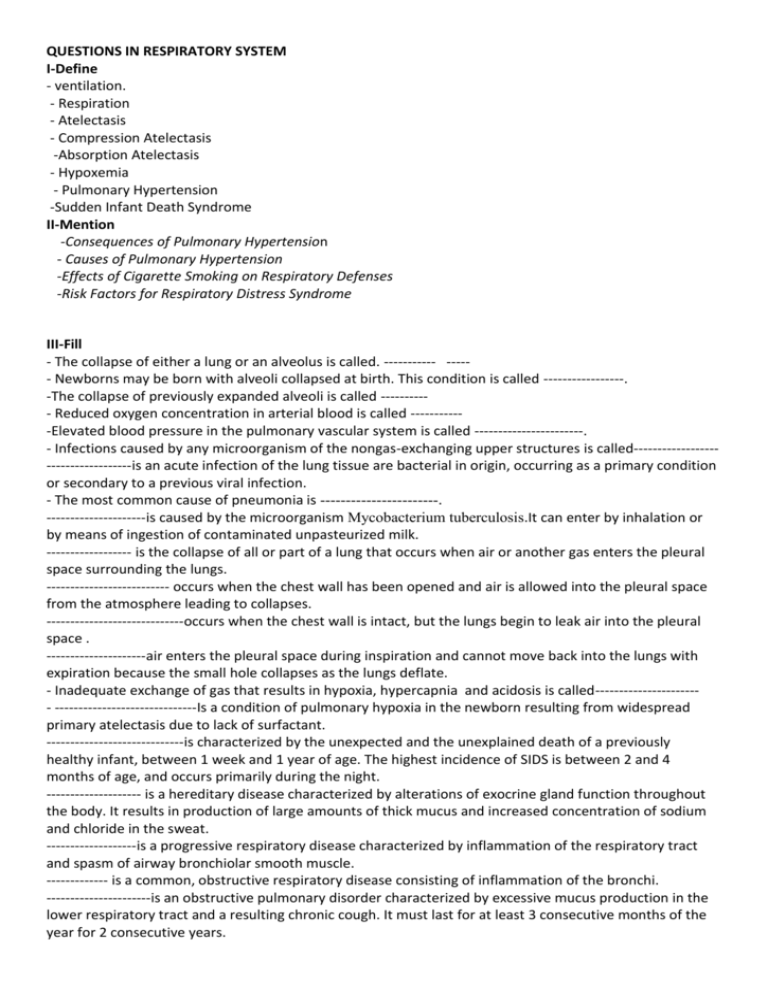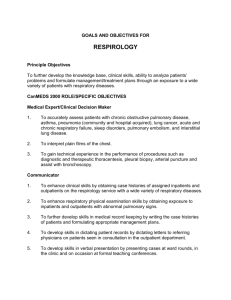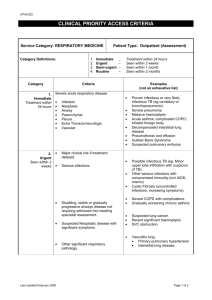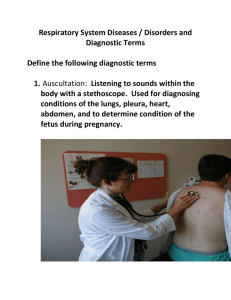QUESTIONS IN RESPIRATORY SYSTEM I-Define
advertisement

QUESTIONS IN RESPIRATORY SYSTEM I-Define - ventilation. - Respiration - Atelectasis - Compression Atelectasis -Absorption Atelectasis - Hypoxemia - Pulmonary Hypertension -Sudden Infant Death Syndrome II-Mention -Consequences of Pulmonary Hypertension - Causes of Pulmonary Hypertension -Effects of Cigarette Smoking on Respiratory Defenses -Risk Factors for Respiratory Distress Syndrome III-Fill - The collapse of either a lung or an alveolus is called. ----------- ----- Newborns may be born with alveoli collapsed at birth. This condition is called -----------------. -The collapse of previously expanded alveoli is called ---------- Reduced oxygen concentration in arterial blood is called -----------Elevated blood pressure in the pulmonary vascular system is called -----------------------. - Infections caused by any microorganism of the nongas-exchanging upper structures is called-----------------------------------is an acute infection of the lung tissue are bacterial in origin, occurring as a primary condition or secondary to a previous viral infection. - The most common cause of pneumonia is -----------------------. ---------------------is caused by the microorganism Mycobacterium tuberculosis.It can enter by inhalation or by means of ingestion of contaminated unpasteurized milk. ------------------ is the collapse of all or part of a lung that occurs when air or another gas enters the pleural space surrounding the lungs. -------------------------- occurs when the chest wall has been opened and air is allowed into the pleural space from the atmosphere leading to collapses. -----------------------------occurs when the chest wall is intact, but the lungs begin to leak air into the pleural space . ---------------------air enters the pleural space during inspiration and cannot move back into the lungs with expiration because the small hole collapses as the lungs deflate. - Inadequate exchange of gas that results in hypoxia, hypercapnia and acidosis is called---------------------- ------------------------------Is a condition of pulmonary hypoxia in the newborn resulting from widespread primary atelectasis due to lack of surfactant. -----------------------------is characterized by the unexpected and the unexplained death of a previously healthy infant, between 1 week and 1 year of age. The highest incidence of SIDS is between 2 and 4 months of age, and occurs primarily during the night. -------------------- is a hereditary disease characterized by alterations of exocrine gland function throughout the body. It results in production of large amounts of thick mucus and increased concentration of sodium and chloride in the sweat. -------------------is a progressive respiratory disease characterized by inflammation of the respiratory tract and spasm of airway bronchiolar smooth muscle. ------------- is a common, obstructive respiratory disease consisting of inflammation of the bronchi. ----------------------is an obstructive pulmonary disorder characterized by excessive mucus production in the lower respiratory tract and a resulting chronic cough. It must last for at least 3 consecutive months of the year for 2 consecutive years. ---------------------- is a chronic obstructive disease characterized by loss of lung elasticity and a reduction in alveolar surface area due the destruction of the alveolar walls and the enlargement of air spaces distal to the terminal bronchioles. IV-TRUE OR FALSE -The alveolar cells that produce surfactant do not mature until between 28 and 32 weeks of gestation. - Infants born to insulin-dependent diabetic mothers are more susceptible to RDS -The more premature the infant, the more likely RDS will develop. -The highest incidence of SIDS is between 2 and 4 months of age, and occurs primarily during the night. -The main body systems affected in cystic fibrosis by the mucus accumulation are the pulmonary and the gastrointestinal systems. -Clinical Manifestations of COPD are those of both emphysema and chronic bronchitis . V-MCQ *Clinical Manifestation of upper resp. tract infections a-Cough b- Sneezing and nasal congestion c - Mucus production d - Headache e- Low-grade fever f- all *Clinical Manifestations of pneumonia include a-Significantly increased respiratory rate. b-Fever and chills c- cough that is often productive d-Chest pain as a result of pleural irritation. * Risk Factors for Tuberculosis Exposure and Infection a- living in close quarters with someone who has an active infection. b- workers caring for the infected individuals c- individuals who have inadequate immune systems. d- all *Clinical Manifestations of Pneumothorax a- Acute onset of pain . b- Rapid, shallow breathing (tachypnea) c- dyspnea are common. d- The chest appears asymmetrical. E all *Diagnostic Tools of respiratory failure a-partial pressure of oxygen in arterial blood of less than 50 mmHg, b-partial pressure of carbon dioxide in arterial blood of greater than 50 mmHg, c- a pH less than or equal to 7.25. d- all *Clinical Manifestations OF RDS a- Increased respiratory rate. b- Intercostal or chest retractions with each breath. c- Nasal flaring with each breath. D all *Clinical Manifestations of cystic fibrosis a-A protuberant abdomen may be apparent soon after birth, resulting from an inability to pass meconium in the first stool. b-Salty taste when kissed, caused by salt buildup from sweat on the skin. c-Repeated respiratory tract infections throughout infancy and early childhood. d-Chronic rhinitis, and chronic cough and sputum production. e-Failure to thrive because nutrients are poorly absorbed. *Clinical Manifestations of asthma a-Significant dyspnea. b-Coughing, especially at night. c-Rapid, shallow breathing. d-Audible wheezing heard only on expiration. e-Chest retractions and, with a worsening of condition, nasal flaring. F- all *Clinical Manifestations of lung casncer a- A persistent cough. b- Recurring lower respiratory tract infections. c- Hemoptysis (the coughing up of blood). e- Weight loss. d- Fatigue. f- all.








